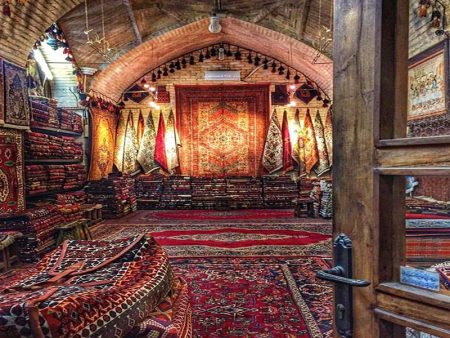
VERNA CARPET – Redesign by Parsineweb





Showing 1–20 of 816 results
What is a hand made rug? How can you tell if a rug is handwoven? The meaning of a hand-woven carpet is that it is made by millions of knots on a loom. These carpets are woven entirely by hand by skilled weavers. They create beautiful patterns of handmade rugs by tying wool or silk fibers on the warp and weft.

Carpet weaving tools
These carpets can make a major difference in your home. A handwoven rug can not only add beauty to your room, but also has many uses. If you are planning to buy a handmade rug, you may be interested in its features. So don’t miss this useful article.

weaving a handmade rug
Handmade carpets have a very long history. This product has undergone a lot of evolution to reach its current form. Cavemen imitated the nesting method of birds and woven Underlays. The problem with these underlays was that they dried out and fell apart over time. So people turned to softer materials like wool and animal skins to make rugs.
After a while, they were able to apply the knotting technique to the warp and weft by inventing the spinning method. In this way, soft rugs were produced from natural fibers such as wool, silk, etc.
You can read this article: Our Earth Needs Green Eco-Friendly Rugs
Most scholars believe that Asia is the birthplace of hand-woven rugs. However, the exact country where rug weaving began is unclear. The oldest hand-woven rug was found in the Pazyryk Valley in Russia. This carpet, called Pazyryk rug, is more than 2,400 years old.

Pazyryk rug, the world’s first carpet
The fibers of the rug are made of wool and cotton, which decompose over time. But Pazyryk was buried under snow and ice and was protected from decay. This rug is almost square and its length is 1.98 meters.

Spotted deer on the Pazyryk carpet
The texture and knots of this rug are similar to Iranian rug. Also, the designs of this carpet include floral borders and images of riders, grazing deer, and mythical animals with the head of an eagle and the body of a lion. These designs are very similar to the carved patterns of Persepolis. Many scholars consider this rug to be from the Achaemenid period. The Pazyryk carpet is currently kept in the Hermitage Museum in Russia.

Horsemen on the Pazyryk carpet
Can a rug be a carpet? Is a rug considered carpet? Their use is almost the same! Both are used to cover the floor and decorate the interior of the house. Perhaps the biggest difference between carpet and rug is their size. The rug is smaller than the carpet.
Carpets are floor coverings that are wall-to-wall and cover the entire floor and are usually glued to the floor. But rugs are those that are used to cover a specific part of the house. Such as the living room or under the dining table. For this reason, it is easier to maintain, clean, and wash the rug.

Persian rugs in Yazd
Iranians have always been interested in using hand-woven rugs in their homes. They gave beauty and warmth to their homes by using this original art. Iranians put their desires, beliefs, dreams, stories, and heroes on the rug.
Each of the carpets has a different story and identity. It is the result of the effort of the weavers who spend their lives weaving the rug. Each rug embraces the soul of the weaver and no two carpets are exactly the same.

Nomads, villages, and cities of Iran each have different designs and rugs. The most important difference between nomadic and urban rugs is in the special designs and coloring of these carpets. The nomads weave whatever they had in mind (lion, peacock, bird, fish, turtle, tree….) according to the culture of the region.
Due to the lack of access to the city, the nomads used limited colors (between 6 and 8 colors) in weaving rugs. They extracted these colors from the plants of their regions. Colors that are long-lasting and become more beautiful with time. Generally, energetic and warm colors are used in nomadic carpets.
Urban weavers used a map to weave rugs. First, the painters would draw subjects on a checkerboard with their preferred scale and then they would give the maps to the weavers. For this reason, urban rugs have a more regular structure and fine texture. Rural and nomadic rugs are woven from sheep wool and goat hair, but urban rugs use silk as well as wool.

Weaving handmade rug
Iranian rug designs are delightful and each one has a unique story. These designs reflect the religion and culture of the Iranian people. These stories are inspired by religious beliefs, elements of nature and history. Let us mention a few examples of Iranian hand-knotted rug designs:

Isfahan rug bazar
The warp is one of the components of a handmade rug. It is the foundation of the rug. Parallel and vertical threads that stretch from the top of the loom to its bottom. The strings are at a certain distance with uniform tension and alternately (one in front and the other in the back). The warps are more than cotton, but wool and silk are also used.
The weft is the second component of a hand-knotted rug. The wefts are horizontal strands that are passed through the warps at a 90-degree angle. The weft is more than cotton. In all silk rugs, the weft is silk.
Pile is the third component of a handmade rug. It is called lints of the rug. Pile is made of wool or silk that is wrapped around the warps. After being knotted, the pile creates the pattern of the rug.
In some rugs, wool is the dominant material, and silk is used to create a little shine in delicate parts of it. The quality of wool depends on the breed of sheep, the climate, the place of pasture and the time of picking the wool.

Components of a handmade carpet

Persian Baluch rug

The most important difference between hand-woven and machine-made carpets is in their roots. In a handwoven carpet, if we follow the rug, we will reach the roots of the rug, and the roots are not separated from the body of the carpet; But in the machine-made rug, the roots are sewn to the carpet.
Please read this article: How to Protect the Roots of the Rug?
If the rug is hand-woven, the knots on the back of the rug are different in terms of size and are a little asymmetrical and irregular, but in machine-made rugs, all the knots are neatly placed together.

Back of handmade rug
The hand-woven carpet is more soft than the machine-made one due to the use of natural fibers, and you will notice this if you touch the rug.
The selvages in handwoven carpets have a sometimes uneven structure because they are stitched by hand. But in machine-made rugs, the selvages are woven by the machine, so it is very uniform and regular.

The value of Iranian handmade rugs is high. The price of a Iranian handmade rug depends on various parameters. The quality of the materials has a great impact on Persian hand-woven rug price. Wool, silk and dyes each have different qualities. Iranian handwoven rugs are woven from high quality natural fibers and they are often dyed with natural dyes, which are better than natural dyes. It is a chemical dye.
These rugs are also woven knot by knot by skilled Iranian weavers, which is why it can take up to 6 years to weave a 12-meter all-silk rug. That’s why if you take good care of a handwoven carpet, it can be used for several generations and adds to its price.

A hand-woven rug is the work of one to several weavers, and creativity, life, and many emotions lie behind it. Those who create a handwoven rug are masters who know well how to create a lasting effect from organic raw materials.
Finally, due to the long rug weaving process, a limited number of rugs can be produced. This is why there are fewer handwoven rugs in the market and this makes the price of hand-knotted rugs higher. Also, no two hand-woven carpets are the same, and by buying each hand-woven rug, you buy a unique work.

Heriz Persian rug
Fold the carpet in half and place the top and bottom of it together. A few centimeters of difference in the dimensions of the rug in the upper and lower parts is normal. To check the symmetry of the design, you can also measure the distance of different points of the rug with a meter. In addition, make sure that the design is not unfinished in any part of the carpet.
The rug should be examined in natural light. The color of the rug has a dark and light side depending on the angle you look at it. The color of the carpet should be uniform throughout its surface. Also, compare the end of the pile with the color of the rug surface to ensure there is no color difference. A color difference indicates that the surface of the rug has been dyed. You can wipe a wet cloth on parts of the carpet to ensure that the colors of the carpet are consistent.

Pulling cotton fabric on carpet to test color
The pile of carpet should be durable, flexible, and shiny. Carpets with thick piles are more durable than rugs with soft piles and get dirty more slowly. The pile height in different parts of the carpet should be the same and without waves.
The back of the carpet says everything. By looking at the back of the rug, you can see the density of knots and the uniformity of the texture of the rug. If there are defects such as rotting or the effects of carpet repair, you can see them on the back of the carpet. The back of the rug should be completely smooth.
Buying a hand-knotted rug is a specialized matter and requires an expert. Determining the price and age of a handmade rug is done with the help of an experienced expert.
You can contact the experts of the Vernacarpets online collection and ask your questions. You can also purchase good rugs at a reasonable price from this Iranian carpet online shop and receive them anywhere in the world within 7 days.